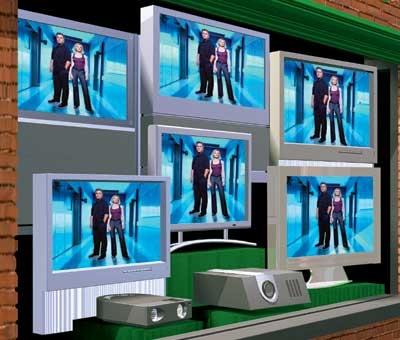Shopping Made Simple: HDTV

What is HDTV, anyway? High-definition television - part of the new digital television (DTV) standard - has much higher resolution and a wider aspect ratio than the analog TV format we've watched for the last half century. Higher resolution means greater picture detail. Aspect ratio is the proportion of screen width to screen height. For HDTV, it's 16:9, or 16 units of width for every nine of height, as compared with the squarish 4:3 shape of conventional TV. This widescreen format is a better match to our visual field and makes home theater more like going to the movies.
There are actually two HDTV formats, 720p and 1080i, both of which can produce stunning images. (For more on what the numbers mean, click to read "Display Formats Decoded.") The good news here is that you don't have to make a choice because all HDTV sets handle both formats.
Do I need any gear besides the set itself to get HDTV? It depends. There are actually three kinds of HDTV sets. Those that have built-in tuners for both digital and analog broadcasts are called just HDTVs, while models that have only analog tuners are called HDTV monitors or referred to as "HD-ready" (most sets fall into this category). Then there are sets - mostly some flat-panel plasma and LCD models - that are just video displays with no tuner at all. For sets in either of the two latter categories, you'll need an outboard digital tuner, or "set-top box," to receive over-the-air HDTV broadcasts and an antenna to pick up those broadcasts (click here to read "Getting HDTV over the Air").
Some HDTV programming is available via satellite, and the number of cable systems carrying high-def is growing weekly (click to see "What's on HDTV"). HDTV-capable satellite boxes usually include digital/analog over-the-air tuners as well, with electronic program guides (EPGs) that integrate information for both satellite and local over-the-air programming. Getting high-def over cable also requires a special box from your cable company. Just about any set with a built-in analog tuner is analog cable-ready, but digital cable-ready is not the same thing.
Does the rectangular shape of an HDTV eliminate the black bars on widescreen movies? Sometimes. HDTV's 16:9 aspect ratio is very close to the 1.85:1 used for many movies - so close, in fact, that if you see any bars at all they'll be very thin. With less common 2.35:1 films, the bars will be more prominent but still thinner than they would be on a regular 4:3 screen. On the other hand, most of today's TV shows and movies made before about 1950 won't fill the width of the screen, which means you'll see bars to the sides of those programs unless they're stretched to fill the screen.
All HDTV displays have stretch and zoom modes that let you do just that. Though stretching the image and zooming in on it will always distort the picture, not all sets are created equal in this respect. Some sets will fill the screen with obviously stretched images, while others keep the images looking as natural as possible. The bottom line: over the long haul, more and more programming will be presented in widescreen - a trend that's already started with some TV shows.
Are there any other advantages to HDTV? Two main ones: First, because the signal is digital, you get an extremely clean, clear picture, free of the noise and ghosting that dogs analog TV. Second, the audio is the same Dolby Digital you're familiar with from DVD movies. Though the sound for many programs is still mono or stereo, many shows on ABC and a few on HBO and Showtime have full 5.1-channel surround sound. Either way, the audio you get with HDTV is always better than with regular analog TV.
- Log in or register to post comments



































































